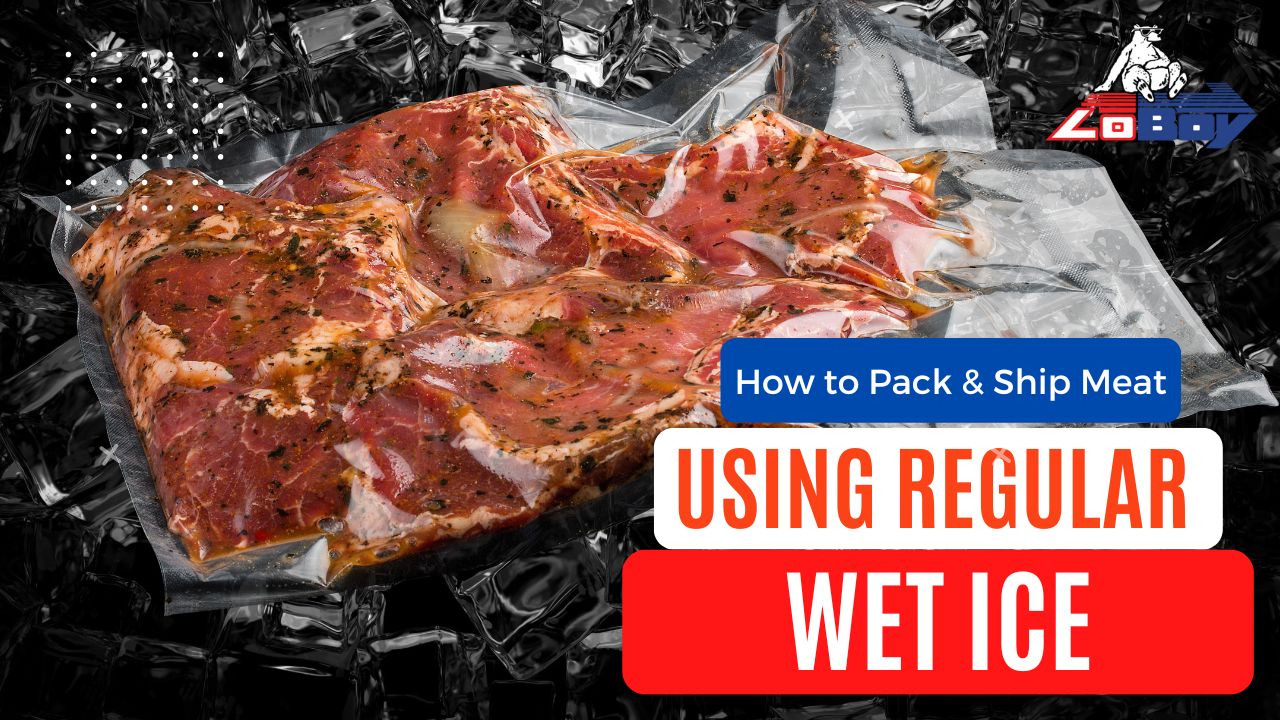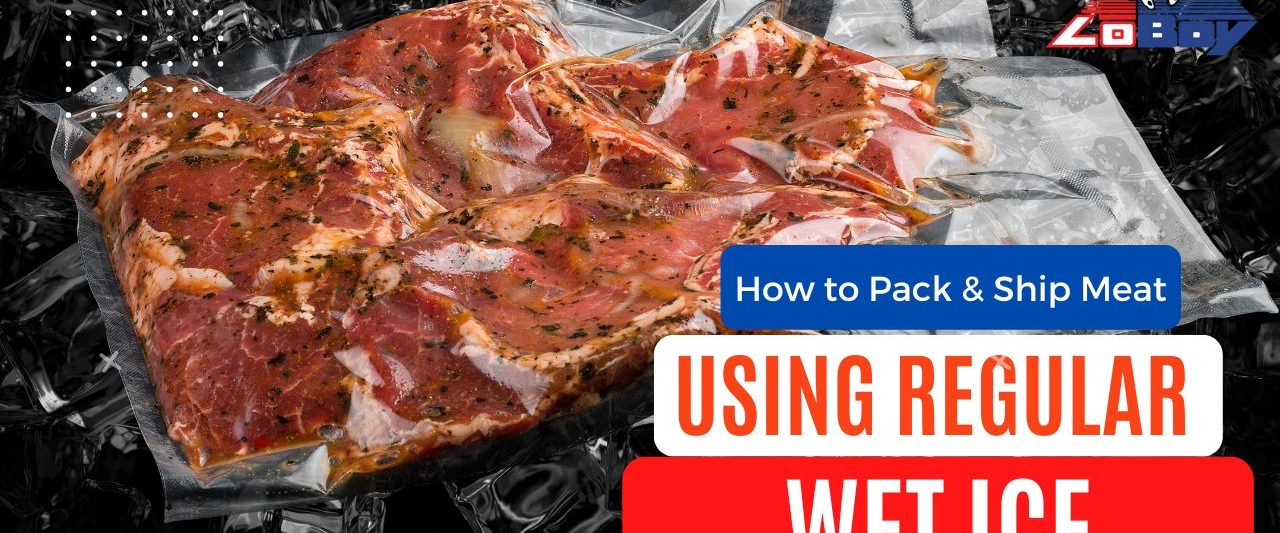
Using Wet Ice as Your Cold Source to Ship Meat
Steps for Shipping Frozen Meat with Frozen Water Ice
Although not a single package shipping carrier recommends using wet ice because of its messy risk, some shipping packages are sent using wet ice as the cooling source, regardless. If you have a good reason for doing so, here are the instructions on how to ship meat with wet ice so that you do it as efficiently as possible.
As long as the shipments are same-day or overnight, and especially if wet ice is combined with, say, frozen Gel-Ice Packs, it works out well enough that businesses still rely on wet ice as a go-to cooling engine.
For most frozen, non-seafood meat shipments, however, water ice is simply a bad idea, so the following instruction on how to do it is strictly for companies who have little choice and for whom changing cooling engines isn't going to happen because everyone involved is perfectly happy, including the customer.
Step #1 - Place the Frozen Meat (brand-packaged or not) in a Chilled Preparation Area
In preparing to pack your insulated shipping cooler box kit full of meat products, it is always a bad idea to assemble your packaging in a warm location. Extend the shelf life of your product and lengthen the effectiveness of your shipping package by putting everything together in a temperature-controlled area.
Step #2 – Ready the EPS Foam Cooler & Outer Shipping Box to serve as a Frozen Meat Shipper
The foam cooler (people call it Styrofoam but it's really EPS) needs to be clean and sanitary along with all the other items in your cold packaging supplies checklist.
The cooler (called Styrofoam but really made from Expanded Polystyrene) and its lid must be clean and sanitary as food prep regulations demand.
Step #3 - Gather Any Bags or Containers of Water Ice in the Cold Room & Divide Them.
Large bags (and obviously buckets) of ice don't fit well into shipment boxes and have to be divvied up and double-bagged into smaller 2mm thick 'baggies' or other ice-holding configurations for easy placement in the cooler with the meat, with ice on the bottom for the meat to sit on top of, ice along the sides and top (as you would with Gel Ice Packs) so that the product is well-cooled all around.
All bags of frozen water ice must be heavily sealed to protect against leaks or punctures. Shipping carriers will not be held responsible for the damage that occurs.
Frozen Water is too vulnerable to heat to justify assembling your insulated shipping package in a warm room, not to mention that frozen meat needs to be packaged and readied in a space where thawing won't kick in.
Step #4 - Protect the Bottom of the Styrofoam Shipping Cooler by Lining it with 2mm plastic
Lining the bottom of the container adds some wetness and leak protection during shipment.
Step #5 - Grab the Rest of Your Insulated Shipping Supplies
Use the following items to finish assembling your frozen meat shipping box:
- Heavy-duty Plastic or Plastic Bag Wrapping, with a 2mm-Thickness
- Plastic Bag Wrapping, 2mm-Thickness, and any Plastic Baggies for Dividing Up Bulk Ice Loads
- Dunnage (filler paper), Foam Packing Peanuts, or similar for filling up empty space and cushioning
- 2-Inch Heavy-duty Box Packing Tape
- Soak Pads and Moisture Soaking Material for Condensation and Wetness
- Temperature Tracker or Data Logger for keeping a record of temperature fluctuations
- FedEx, UPS, USPS, or other Shipping Carrier Labels and required Regulatory Labels
- Carrier Shipping Label
Ask the shipping carrier if there are any other special requirements for your operation.
Step #6 – Wrap the Frozen Meat Securely in a 2mm Heavy-duty Layer
To close and secure it, twist the bottom of the plastic-enclosed package while holding the top so that it spins around, tightening as any bag would, squeezing out excess air and forming a twist that you can tie into a knot or fold over to clip, apply rubber bands, or a zip tie.
Step #7 – Use Moisture Padding or Absorbent Material for lining the bottom of the Styrofoam Shipper
Put it on top of the plastic already laid down to protect from wetness as a double layer of security against wetness.
Step #8 – Add Your Ice Bags or Pouches, already Double-wrapped in 2mm Plastic
After the meat is secure, put the ice bags to go beneath the products and some to fit around its sides and on top before putting in any more filler to take up the remaining empty cubic footage.
You should be looking to ensure enough ice packets to cocoon the meat to keep out heat.
Once the Wet Ice starts to melt - and it starts quickly - it becomes a thermal liability and as the melting water warms it gradually warms your package interior.
That is why shippers like FedEx only accept Overnight delivery when taking possession of the shipment.
Step #9 - Add Any Thermal Temperature Trackers or Data Loggers
For companies who are tracking their package heat ranges as it travels from state to state, sit on trucks and in warehouses to monitor the quality and reliability of all shipping steps and resources. Put the device or patch or stip where desired within.
Step #10 - Tape Shut the Shipping Cooler Lid, Sealing All Four Sides Airtight
Even if the cooler lid is hinged with tape or velcro, all seams must still be sealed not just to keep warm air out but to prevent worse condensation and faster meltwater accumulation.
Step #11 - Snuggly Insert the Sealed Styrofoam Shipper into the Heavy Duty Corrugated Cardboard Box
If you are putting multiple shipping packages in one larger box, you may wish to add packing peanuts or other dunnage and space filler. Being lightweight, thus barely affecting your shipping costs, the added peace of mind is worth it.
Step #12 - Close the Outer Shipping Box and Tape Shut in an 'H' Pattern so all Flaps are Sealed Airtight
Since cardboard is somewhat flexible, it's nearly impossible to get a completely airtight seal that will last, but the 'H Pattern' taping will prove strong enough to keep the flaps from coming apart, exposing the inner cooler.
Step #13 – Mark Outer Box as Required and Add Shipping Label(s)
Your package is ready once all labels and markings have been applied and you can have it picked up or take it to your preferred delivery vendor.
You can now call your shipping company or take the package to them safe in the knowledge that you've assembled an insulated shipping package of frozen meat that stands the best chance of reaching the customer in great shape for a pleasant user experience.

